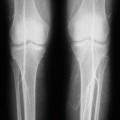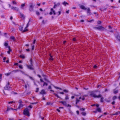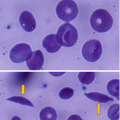(1)
Department of Surgery, Dar A lAlafia Medical Company, Qatif, Saudi Arabia
13.1 Introduction
The pathophysiology of sickle cell anemia is basically related to abnormalities of RBCs leading to sickling, aggregation of sickled RBCs, and blockage of terminal arterioles, but other factors play an important role as well including:
Endothelial activation
Inflammation
Nitric oxide bioavailability
Oxidative stress
Regulation of the adhesiveness of several types of blood cells including platelets and WBC
Blockage of blood flow in the terminal arterioles by sickled RBCs will lead to sluggish blood flow, tissue hypoxia, and acidosis. This causes further sickling, increased blood viscosity, and decreased blood flow.
All of these factors are important in the pathogenesis of ophthalmic manifestation of sickle cell anemia.
The exact frequency of sickle cell-related complications is not known but visual abnormalities in any stage of life of a patient with sickle cell anemia is reported to be 10–20 %.
The frequency of sickle cell retinopathy is greatest in adulthood, but retinopathy has also been described in children.
A meticulous eye examination is necessary in these patients to detect the early changes of sickle cell anemia.
This ophthalmic assessment should be periodic and include:
Measurement of visual acuity
Measurement of intraocular pressure
Evaluation of the anterior/posterior segment structures by fluorescein angiography
Ophthalmic manifestation of sickle cell anemia can affect the:
Orbit
Conjunctiva
Iris
Uvea
Papillary and retinal changes
The most relevant anterior segment abnormalities are:
The conjunctival sign
Iris atrophy
Hyphema
The retinal manifestations of sickle cell anemia can be:
Nonproliferative
Proliferative
The proliferative changes are more serious and associated with a real risk of ocular morbidity.
Nonproliferative retinopathy includes venous tortuosity which is nonspecific, but it is seen in about 50 % of patients with SCA.
The ocular manifestations of sickle cell anemia result from vascular occlusion. Sickle cell vaso-occlusive events can affect every vascular bed in the eye and may occur in the conjunctiva, iris, retina, and choroid.
These changes are however not unique to sickle cell anemia and can be seen with other diseases such as diabetes mellitus, central retinal artery or vein thrombosis, familial exudative vitreoretinopathy, polycythemia vera, and uveitis.
Angioid streaks:
Angioid streaks occur in association with sickle cell anemia, with an overall incidence of less than 6 %.
The changes are age dependent, occurring in 2 % of sickle cell anemia patients less than 40 years of age versus 22 % in those who are more than 40 years of age.
Epiretinal membranes:
Epiretinal membranes may produce visual loss in patients with sickle cell anemia.
Macular epiretinal membranes are seen more frequently in those with retinal neovascularization, retinal tears, and vitreous hemorrhage, as well as those that have had laser treatment or surgery of the retina or vitreous.
Progressive visual loss from macular distortion is well known seen in up to 30 % of these patients.
Peripheral neovascularization may stimulate formation of epiretinal membranes by transudation of plasma and RBCs into the vitreous, disrupting the vitreous cortex and inducing posterior vitreous detachment.
Successful treatment of the neovascular tissue reduces the risk of epiretinal membrane development by approximately 30 %.
Although spontaneous separation of epiretinal membranes following treatment of peripheral neovascularization has been observed, surgical removal may be considered when patients exhibit moderate to severe visual loss.
Traction across the macula from peripheral neovascularization is thought to contribute to the formation of macular holes in sickle cell retinopathy.
Conjunctival sickle sign:
Abnormalities of the bulbar conjunctival blood vessels are believed to be the result of flow obstruction by sickled cells.
These abnormalities include:
Linear dilatations, interrupted, dilated, and truncated vascular segments
Iris atrophy and neovascularization:
Occlusions of the iris vessels can result in atrophy, and patients may present with asymptomatic white patches of the iris.
Iris neovascularization may develop in eyes with chronic retinal detachment or major arteriole occlusions and can in rare cases cause a secondary neovascular glaucoma.
Hyphema:
Sickle cell patients are susceptible to develop central retinal artery occlusions and optic atrophy secondary to elevated intraocular pressure.
Retinal artery occlusions:
Occlusions of the central retinal artery and major arteriolar branches are seen most frequent in young patients with sickle cell anemia.
They may cause permanent or transient visual loss and can occur simultaneously in both eyes.
Arterial occlusion has also been reported to occur as a complication of retrobulbar anesthesia and following compression of the eye during photocoagulation.
Retinal venous occlusions:
Retinal venous occlusions are surprisingly uncommon in patients with sickle cell anemia.
The reason for this is not known but anemia and low blood pressure present in sickle cell patients may be protective against venous occlusions.
An underlying systemic disease associated with a higher incidence of venous occlusions (e.g., hypertension) should be suspected when a venous occlusion occurs in a patient with sickle cell anemia.
Macular small vessel occlusions:
Occlusions of the fine vasculature of the macular and perimacular area have been reported in 10–40 % of patients with sickle cell anemia.
In the acute phase, the occluded vessel will have a dark red appearance and may appear as a dark line on fluorescein angiography.
Nerve fiber layer infarcts (cotton-wool spots) are also seen.
Other macular and perimacular changes include:
Microaneurysm-like dots
Dark and enlarged segments of arterioles
Hairpin-shaped venular loops
Pathologic avascular zones
Widening and irregularities of the foveal avascular zone
Careful examination by fluorescein angiograph, is often necessary to identify these macular changes.
These changes may be transient, and the macula may appear normal on subsequent fluorescein angiograms.
A loss of the inner retinal layers results in an ophthalmoscopic focal concavity with an abnormal reflex (retinal depression sign). These changes are usually permanent.
The retinal depression sign is not pathognomonic of sickle cell anemia and may be seen with other arteriolar occlusive diseases, such as embolic retinopathy, vasculitis, and hypertension.
Macular function tests in sickle cell anemia:
The visual acuity in patients with sickle cell anemia is often normal, despite the presence of an enlarged foveal avascular zone or other evidence of sickle cell maculopathy.
In addition, patients with sickle cell maculopathy have a remarkable absence of visual complaints.
Automated visual field analysis has demonstrated significantly larger scotomas in patients with abnormally enlarged foveal avascular zone.
Color vision testing has revealed a greater incidence of blue-yellow defects in patients with sickle cell retinopathy; however, no significant correlation has been demonstrated between color vision defects and the presence of sickle cell maculopathy.
Choroidal vascular occlusions:
Choroidal vascular occlusions may occur focally at the level of the choroidal precapillary arteriole or capillary bed (Elschnig’s spots) or from posterior ciliary artery occlusion.
Although focal precapillary arteriole occlusions have not been specifically identified in patients with sickle cell anemia, clinical and histopathologic evidence of spontaneous posterior ciliary artery occlusions have been reported in sickle cell anemia.
The findings are similar to those described following compression of the eye during general anesthesia and after peripheral photocoagulation.
In the acute phase, the occlusions appear as white, circumscribed, triangular patches at the level of the retinal pigment epithelium and outer retina.
Subsequently, the white lesions fade and retinal pigment epithelial mottling develops.
Patients with acute ciliary artery occlusions may be asymptomatic and the diagnosis is often based solely on the appearance of peripheral pigment mottling.
In sickle cell anemia, it has been suggested that choroidal ischemia plays a role in the development of angioid streaks.
Retinal hemorrhages, iridescent spots, and black sunbursts:
When an arteriole of intermediate size is occluded by sickled erythrocytes, hemorrhage may occur.
The hemorrhages typically appear adjacent or distal to an intraluminal obstruction. It is likely that ischemic necrosis causes a weakening of the vessel wall and that reperfusion of the vessel causes a rupture of the damaged vessel wall, resulting in a hemorrhage.
This type of hemorrhage is round or oval shaped and bright red and measures 1/4–1 disk diameter.
Retinal hemorrhages (“salmon patches”), found most commonly in the equatorial periphery.
These hemorrhages are bright red, but after several days, the partially degenerated blood acquires a characteristic orange-red color (hence the name salmon patch).
In most cases, these hemorrhages are asymptomatic.
The majority of these hemorrhages remain confined to the sensory retina; however, blood may leak through the internal limiting membrane into the vitreous or dissect deeper into the subretinal space.
Resolution occurs over days to weeks and may result in a focal area of atrophic split retina (a “schisis” cavity), a pigmented retinal scar, or a grayish-white vitreous deposit, depending on the location of the hemorrhage. The blood is slowly cleared by macrophages.
Over time, hemoglobin degradation occurs. The hemorrhagic defect then appears as bright yellow dots at several levels of the sensory retina; these are known as iridescent bodies.
If the hemorrhage occurs in the outer retinal layers, it appear as dark, oval or round, 1/4–2 disk-diameter chorioretinal lesions. These lesions, which are similar in appearance to chorioretinitis scars, are known as black sunbursts.
The hemorrhages are temporary, and those that occur in the posterior part of the eye are difficult to diagnose. Their late signs, such as iridescent bodies and black sunbursts, can be observed in approximately 25–40 % of cases and are seen more frequent in SCA.
Stay updated, free articles. Join our Telegram channel

Full access? Get Clinical Tree







